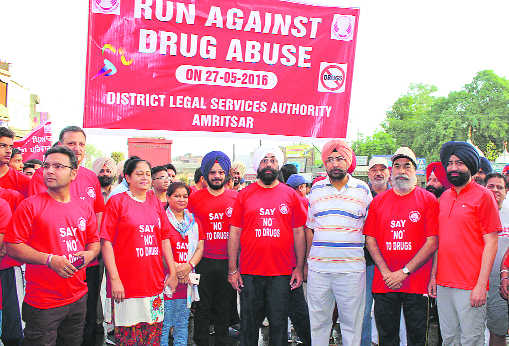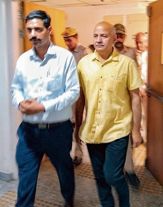
The district legal services authority takes out an awareness rally against drugs in Amritsar.
PPS Gill
The question is not whether Udta Punjab will have a bearing or not on the electoral prospects of the SAD-BJP in 2017. The question is why the Akali/BJP leadership is persistently rubbishing all talk of Punjab being high on drugs, calling it a “conspiracy to defame” the state, despite availability of numerous reports in print/online, based on surveys/studies, including by the government institutions/instrumentalities.
How long can the Deputy Chief Minister remain in denial mode on drug abuse? Obstinate and ostrich-like stand would not help. Sadly, despite his tall claims, the infrastructure/ apparatus of drug trafficking and consumption remains intact, notwithstanding registration of thousands of FIRs, across the state under the Narcotic Drugs and Psychotropic Substances Act, 1985. This shoddy cosmetic action (2014-15) against small-time carriers/ couriers or shoving petty addicts into ill-equipped de-addiction/ inhospitable rehabilitation clinics/jails is no proof of government's seriousness in tackling the situation.
The Deputy Chief Minister may, perhaps, remember that Punjab found a special mention for "drug abuse and trafficking" in the Prime Minister's “Mann Ki Baat” AIR talk-show (December 15, 2014), when he drew nation's attention to this serious “disease”, calling it “drug-terror”.
Drug abuse is a “psycho-socio-medical” problem. And, drug mafia operations are not possible without political, police patronage.
The latest report on drug abuse: Punjab Opioid Dependence Survey is by the Society for Promotion of Youth and Masses (SPYM) and National Drug Dependence Treatment Centre, All-India Institute of Medical Sciences, New Delhi, done in collaboration with Department of Health and Family Welfare, Punjab. Conducted in February-April, 2015, it is based on a field study in Bathinda, Ferozepur, Gurdaspur, Hoshiarpur, Jalandhar, Kapurthala, Moga, Patiala, Sangrur and Tarn Taran, which house about 60 per cent of the population; are representative of the entire state on many parameters: population, male: female ratio, urban: rural ratio, location at international or inter-state border, representing different regions. It says the most drug-dependent people use opioid group of drugs: heroin, opium, Doda, Bhuki, pharmaceutical opioid etc.
A comprehensive report, “Substance abuse in Punjab” (2001), commissioned by the Punjab Department of Planning and compiled by the Institute for Development and Communication is relevant. It links drug abuse to Punjab's “culture”. Punjab serves as transit route/conduit for illicit traffic of drugs (heroin, brown sugar, charas, ganja and opium), given its proximity to the “golden triangle” (Laos, Thailand, Burma) and the “golden crescent” (Iran, Afghanistan, Pakistan), which supply more than 70 per cent of the drugs to the world. In Punjab, smuggling, finding couriers, consumers is easy because here villages are close to the international border and land is cultivated right up to the fence, unlike in Rajasthan and Gujarat.
At the instance of the World Health Organisation, World Bank, the Punjab Health Department conducted a study (2001), which revealed that every third male and every tenth female student in the state has had drugs on some pretext or on one occasion or the other. A sample survey of nearly 5,000 students reported the highest prevalence of drug abuse in the 16 -25 year age group.
The state's own Department of Social Security Development of Women and Children's website draws attention to the “alarming” situation and talks of “dark days” ahead, given Punjab's “drug epidemic”. It says in the border-belt rate of heroin abuse among the youth (15 - 25 years) is as high as 75 per cent; the percentage for other rural areas is 73. Secondly, as many as 67 per cent rural households have at least one addict in the family; and each week sees at least one death in the region attributable to drug overdose. The listed “recreation” drugs on the official website include Bhuki (powdered opium) and bhang — both considered the “gateway” to drugs, as these give “mild intoxication”. Next is heroin. and then opium, its derivatives; and morphine. It says, several brands of “tooth-paste” in the region containing “nicotine” are a craze. There are reports of excessive use of these tooth-pastes, being relatively cheap and easily available and give a “nicotine high”. Also listed are poppy-husk, cocaine, bhang, smack, beedi, fortwin and morphine injections, alcohol, etc. The reasons for high drug abuse are “easy availability and access” to the “substances” and the “green revolution.” Since rural youth do not find off-farm jobs anywhere, it makes them vulnerable to drugs and also leads to crime. With the “green revolution” losing its steam, there appeared "technological fatigue.” Income growth slowed down, employment opportunities shrunk and agricultural economy stagnated; while aspirations of the youth soared. Another reason for drug abuse is “narco-terrorism”.
Surveys reveal that 53 per cent males and 48 per cent females are prone to drug addiction. A Punjab Agricultural University survey showed that about three-fourths of the rural male adults were habitual drug takers in 22.83 per cent of the villages. Substance abuse was fairly widespread, across all three distinct regions: Doaba reported 68.6 per cent addiction, Malwa 64.69 per cent and Majha 61 per cent. Even the type and variety of drugs consumed varied in the three regions.
Ravneet Kaur and Jatinder K Gulati in their study, “Drug abuse: trends and issues”, (2007) attributed this problem to “sub-culture” in the society. It gives a long list of commonly used (abused) drugs prepared by the National Institute on Drug Abuse: canabinoids to stimulants to depressants; namely, marijuana, cocaine, amphetamines, methamphetamine-mine, MDMA (street name Adam), barbiturates, benzodiazepines, heroin, LSD (hallucinogen), PCP (dissociative anaesthetics) inhalant, anabolic steroids. 'ICE' (methamphetamine, a synthetic drug), “codeine cough syrup”, “ink-correction fluid”, “foils” of psychotropic drugs and pain killers, as some other substances in use in the state.
“Factors driving drug abuse in India's Punjab,” a study by Rahul Advani (September 2013) reported that 60 per cent of all illicit drugs confiscated in India are seized in Punjab and that "injecting drug use" is of recent onset. Advani is a research assistant at the Institute of South Asian Studies, National University of Singapore. According to “Drug abuse and alcoholism in Punjab” (2011) a report of the Union Ministry of Youth Affairs and Sports, 40 per cent youth (15 - 25 years) has fallen prey to drug abuse. The consequence: “crime, broken homes, destroyed families and children's emotional, psychological and development problems”.
The writer, a senior journalist, is a former Chief Information Commissioner, Punjab



























